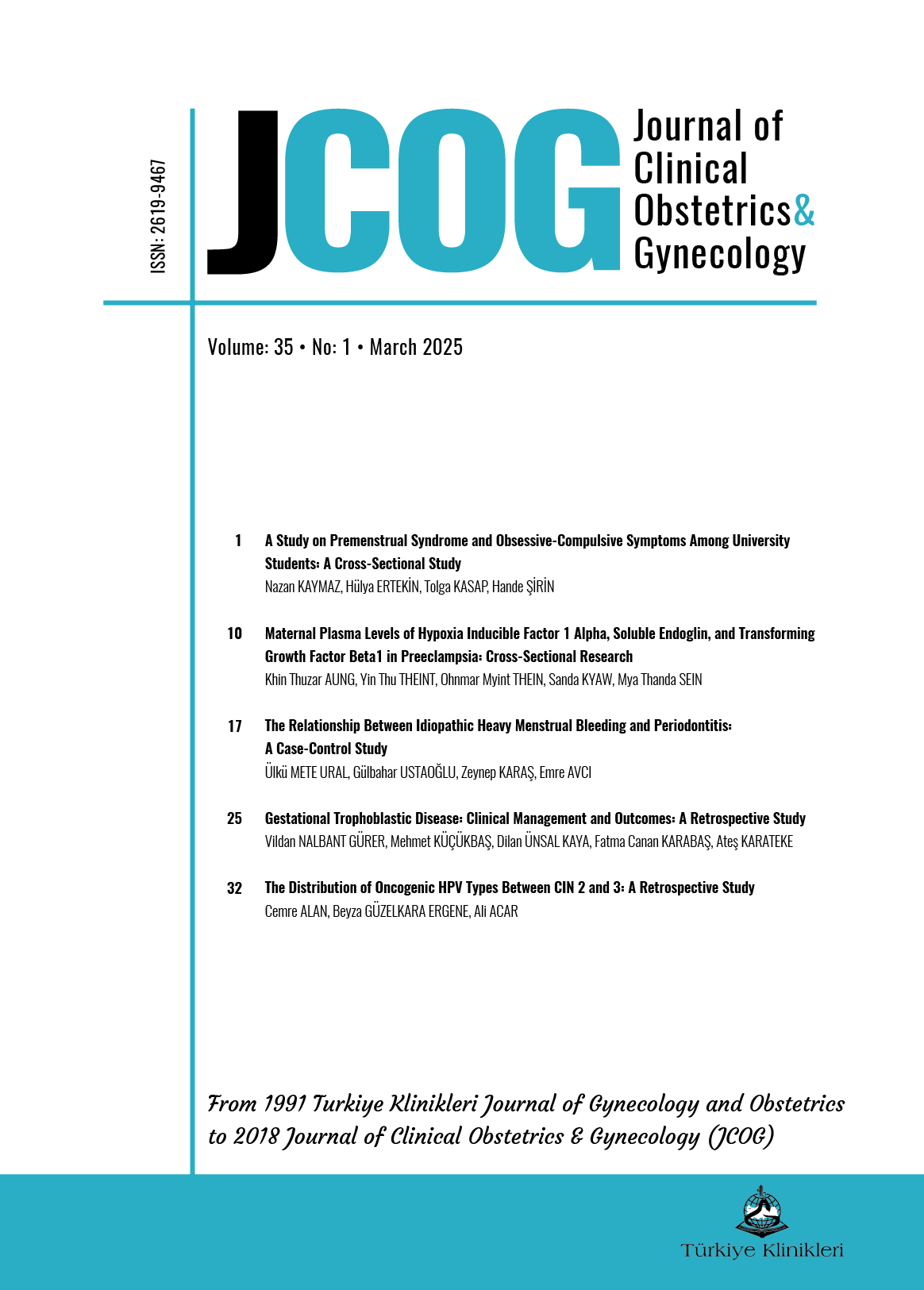Open Access
Peer Reviewed
ORIGINAL RESEARCH
921 Viewed726 Downloaded
The Distribution of Oncogenic HPV Types Between CIN 2 and 3: A Retrospective Study
Received: 16 Oct 2024 | Received in revised form: 09 Dec 2024
Accepted: 19 Dec 2024 | Available online: 14 Feb 2025
JCOG. 2025;35(1):32-8
DOI: 10.5336/jcog.2024-106307
Article Language: EN
Article Language: EN
Copyright Ⓒ 2025 by Türkiye Klinikleri. This is an open access article under the CC BY-NC-ND license (http://creativecommons.org/licenses/by-nc-nd/4.0/)
ABSTRACT
Objective: Cervical cancer is a major public health problem worldwide. The most important risk factor is persistent infection with oncogenic human papillomavirus (HPV) types. The distribution of HPV genotypes varies geographically. There are differences in HPV types depending on the degree of cervical intraepithelial neoplasia (CIN). This study aimed to compare patients diagnosed with CIN 2 or 3 by colposcopic biopsy about the high-risk HPV types they carry. Material and Methods: Between January 2013 and September 2024, 229 patients diagnosed with CIN 2 or 3 and attending the gynecological oncology outpatient clinic of the university hospital were included in the study. The distribution of high-risk HPV types according to age and pathological diagnosis was investigated. Results: HPV 16 positivity was significantly higher in patients diagnosed with CIN 3 than CIN 2 (p=0.003). The prevalence of HPV 16 and 39 was significantly higher in patients aged 40 and older compared to those under 40 (p=0.003, p=0.018, respectively). Conclusion: In conclusion, HPV 16 positivity was significantly higher in patients diagnosed with CIN 3 than with CIN 2 (p=0.003). The most common HPV types in patients with CIN 2/3 in this study were 16, 18, 31, 35, 39, and 51 (the last three were equally frequent). In addition, more than half of the patients diagnosed with CIN 2/3 are positive for high-risk HPV types other than HPV 16-18.
Objective: Cervical cancer is a major public health problem worldwide. The most important risk factor is persistent infection with oncogenic human papillomavirus (HPV) types. The distribution of HPV genotypes varies geographically. There are differences in HPV types depending on the degree of cervical intraepithelial neoplasia (CIN). This study aimed to compare patients diagnosed with CIN 2 or 3 by colposcopic biopsy about the high-risk HPV types they carry. Material and Methods: Between January 2013 and September 2024, 229 patients diagnosed with CIN 2 or 3 and attending the gynecological oncology outpatient clinic of the university hospital were included in the study. The distribution of high-risk HPV types according to age and pathological diagnosis was investigated. Results: HPV 16 positivity was significantly higher in patients diagnosed with CIN 3 than CIN 2 (p=0.003). The prevalence of HPV 16 and 39 was significantly higher in patients aged 40 and older compared to those under 40 (p=0.003, p=0.018, respectively). Conclusion: In conclusion, HPV 16 positivity was significantly higher in patients diagnosed with CIN 3 than with CIN 2 (p=0.003). The most common HPV types in patients with CIN 2/3 in this study were 16, 18, 31, 35, 39, and 51 (the last three were equally frequent). In addition, more than half of the patients diagnosed with CIN 2/3 are positive for high-risk HPV types other than HPV 16-18.
REFERENCES:
- Arbyn M, Weiderpass E, Bruni L, de Sanjosé S, Saraiya M, Ferlay J, Bray F. Estimates of incidence and mortality of cervical cancer in 2018: a worldwide analysis. Lancet Glob Health. 2020;8(2):e191-e203. Erratum in: Lancet Glob Health. 2022;10(1):e41. [Crossref] [PubMed] [PMC]
- Kang WD, Oh MJ, Kim SM, Nam JH, Park CS, Choi HS. Significance of human papillomavirus genotyping with high-grade cervical intraepithelial neoplasia treated by a loop electrosurgical excision procedure. Am J Obstet Gynecol. 2010;203(1):72.e1-6. [Crossref] [PubMed]
- Chan CK, Aimagambetova G, Ukybassova T, Kongrtay K, Azizan A. Human Papillomavirus Infection and Cervical Cancer: Epidemiology, Screening, and Vaccination-Review of Current Perspectives. J Oncol. 2019;2019:3257939. [Crossref] [PubMed] [PMC]
- Serrano B, Alemany L, Tous S, Bruni L, Clifford GM, Weiss T, et al. Potential impact of a nine-valent vaccine in human papillomavirus related cervical disease. Infect Agent Cancer. 2012;7(1):38. [Crossref] [PubMed] [PMC]
- Purut YE, Uçkan K. Could HPV Type 33 Be More Risky Than We Thought? Int J Surg Pathol. 2023;31(1):4-10. [Crossref] [PubMed] [PMC]
- González-Yebra B, Mojica-Larrea M, Alonso R, González AL, Romero-Morelos P, Taniguchi-Ponciano K, et al. HPV infection profile in cervical lesions. Gac Med Mex. 2022;158(4):222-8. English. [Crossref] [PubMed]
- US Preventive Services Task Force; Curry SJ, Krist AH, Owens DK, Barry MJ, Caughey AB, Davidson KW, et al. Screening for Cervical Cancer: US Preventive Services Task Force Recommendation Statement. JAMA. 2018;320(7):674-86. [Crossref] [PubMed]
- Yaslı G. Türkiye'de servikal kanser tarama programı saha değerlendirmesi [Field evaluation of the national screening program for cervical cancer in Turkey]. Sağlık ve Toplum. 2022;32(3):14-22. [Link]
- Ronco G, Giorgi-Rossi P, Carozzi F, Confortini M, Dalla Palma P, Del Mistro A, et al; New Technologies for Cervical Cancer screening (NTCC) Working Group. Efficacy of human papillomavirus testing for the detection of invasive cervical cancers and cervical intraepithelial neoplasia: a randomised controlled trial. Lancet Oncol. 2010;11(3):249-57. [Crossref] [PubMed]
- Berger L, Wolf-Breitinger M, Weiß C, Tuschy B, Berlit S, Sütterlin M, et al. Prevalence of higher-grade dysplasia in persistently high-risk human papillomavirus positive, cytology negative women after introduction of the new cervical cancer screening in Germany. Cancer Causes Control. 2023;34(5):469-77. [Crossref] [PubMed] [PMC]
- Zhang J, Cheng K, Wang Z. Prevalence and distribution of human papillomavirus genotypes in cervical intraepithelial neoplasia in China: a meta-analysis. Arch Gynecol Obstet. 2020;302(6):1329-37. [Crossref] [PubMed] [PMC]
- Stoler MH, Wright TC Jr, Parvu V, Yanson K, Cooper CK, Andrews J. Stratified risk of high-grade cervical disease using onclarity HPV extended genotyping in women, ≥25 years of age, with NILM cytology. Gynecol Oncol. 2019;153(1):26-33. [Crossref] [PubMed]
- Kietpeerakool C, Kleebkaow P, Srisomboon J. Human Papillomavirus Genotype Distribution among Thai Women with High-Grade Cervical Intraepithelial Lesions and Invasive Cervical Cancer: a Literature Review. Asian Pac J Cancer Prev. 2015;16(13):5153-8. [Crossref] [PubMed]
- Bornstein J, Bentley J, Bösze P, Girardi F, Haefner H, Menton M, et al. 2011 colposcopic terminology of the International Federation for Cervical Pathology and Colposcopy. Obstet Gynecol. 2012;120(1):166-72. [Crossref] [PubMed]
- Bülbül M, Dilbaz B, Aydın Türk B, Hatipoğlu F, Boyar E. Human papilloma virus genotype distribution in women with cervical intraepithelial neoplasia. Journal of Clinical Obstetrics & Gynecology. 2018;28(3):112-20. [Crossref]
- Tjalma WA, Fiander A, Reich O, Powell N, Nowakowski AM, Kirschner B, et al; HERACLES/SCALE Study Group. Differences in human papillomavirus type distribution in high-grade cervical intraepithelial neoplasia and invasive cervical cancer in Europe. Int J Cancer. 2013;132(4):854-67. [Crossref] [PubMed]
- Zhang Q, Zhao M, Cao D, Wei X, Wang L, Li Y, et al. Assessment of the effectiveness of HPV16/18 infection referred for colposcopy in cervical cancer screening in Northwest of China. J Med Virol. 2018;90(1):165-71. [Crossref] [PubMed] [PMC]
- Gultekin M, Karaca MZ, Kucukyildiz I, Dundar S, Keskinkilic B, Turkyilmaz M. Mega Hpv laboratories for cervical cancer control: Challenges and recommendations from a case study of Turkey. Papillomavirus Res. 2019;7:118-122. [Crossref] [PubMed] [PMC]
- Kabaca C, Giray B, Guray Uzun M, Akis S, Purut YE, Keles Peker E, et al. The meaning of high-risk HPV other than type 16/18 in women with negative cytology: Is it really safe to wait for 1 year? Diagn Cytopathol. 2021;49(4):480-6. [Crossref] [PubMed]
- TOMBOLA Group. Cytological surveillance compared with immediate referral for colposcopy in management of women with low grade cervical abnormalities: multicentre randomised controlled trial. BMJ. 2009;339:b2546. [Crossref] [PubMed] [PMC]
- Dijkstra MG, van Niekerk D, Rijkaart DC, van Kemenade FJ, Heideman DA, Snijders PJ, et al. Primary hrHPV DNA testing in cervical cancer screening: how to manage screen-positive women? A POBASCAM trial substudy. Cancer Epidemiol Biomarkers Prev. 2014;23(1):55-63. [Crossref] [PubMed]
- Rijkaart DC, Berkhof J, Rozendaal L, van Kemenade FJ, Bulkmans NW, Heideman DA, et al. Human papillomavirus testing for the detection of high-grade cervical intraepithelial neoplasia and cancer: final results of the POBASCAM randomised controlled trial. Lancet Oncol. 2012;13(1):78-88. [Crossref] [PubMed]
- Kitchener HC, Almonte M, Thomson C, Wheeler P, Sargent A, Stoykova B, et al. HPV testing in combination with liquid-based cytology in primary cervical screening (ARTISTIC): a randomised controlled trial. Lancet Oncol. 2009;10(7):672-82. Erratum in: Lancet Oncol. 2009;10(8):748. [Crossref] [PubMed]
- Giannella L, Giorgi Rossi P, Delli Carpini G, Di Giuseppe J, Bogani G, Gardella B, et al. Age-related distribution of uncommon HPV genotypes in cervical intraepithelial neoplasia grade 3. Gynecol Oncol. 2021;161(3):741-7. [Crossref] [PubMed]
- Rositch AF, Burke AE, Viscidi RP, Silver MI, Chang K, Gravitt PE. Contributions of recent and past sexual partnerships on incident human papillomavirus detection: acquisition and reactivation in older women. Cancer Res. 2012;72(23):6183-90. [Crossref] [PubMed] [PMC]
- González P, Hildesheim A, Rodríguez AC, Schiffman M, Porras C, Wacholder S, Piñeres AG, Pinto LA, Burk RD, Herrero R. Behavioral/lifestyle and immunologic factors associated with HPV infection among women older than 45 years. Cancer Epidemiol Biomarkers Prev. 2010;19(12):3044-54. [Crossref] [PubMed] [PMC]
- Carozzi FM, Tornesello ML, Burroni E, Loquercio G, Carillo G, Angeloni C, et al; HPV Prevalence Italian Working Group. Prevalence of human papillomavirus types in high-grade cervical intraepithelial neoplasia and cancer in Italy. Cancer Epidemiol Biomarkers Prev. 2010;19(9):2389-400. [Crossref] [PubMed]
- Stolnicu S, Allison D, Patrichi A, Flynn J, Iasonos A, Soslow RA. Invasive squamous cell carcinoma of the cervix: a review of morphological appearances encountered in Human Papillomavirus-associated and Papillomavirus-independent Tumors and precursor lesions. Adv Anat Pathol. 2024;31(1):1-14. [Crossref] [PubMed] [PMC]
MENU
POPULAR ARTICLES
MOST DOWNLOADED ARTICLES





This journal is licensed under a Creative Commons Attribution-NonCommercial-NoDerivatives 4.0 International License.










